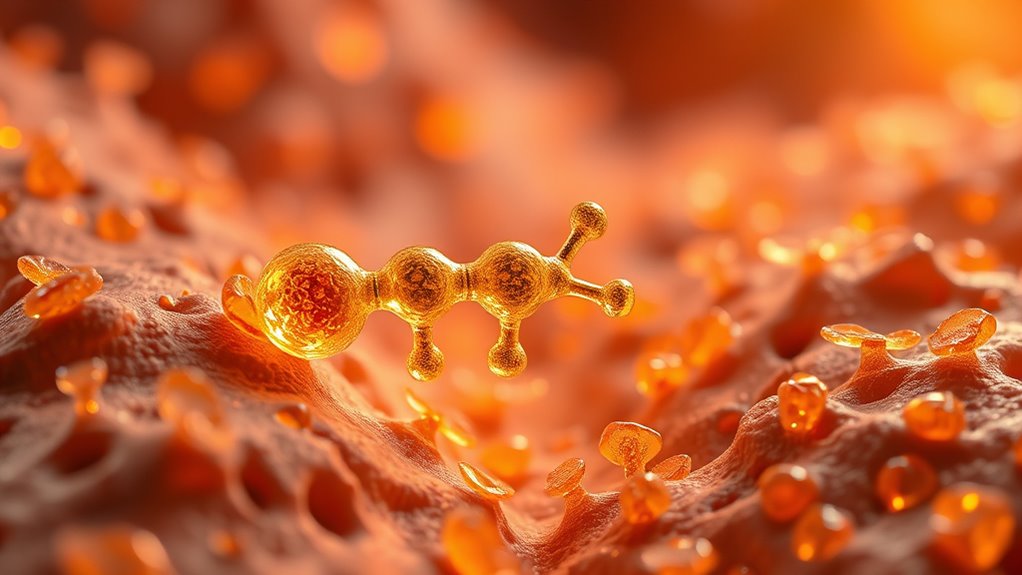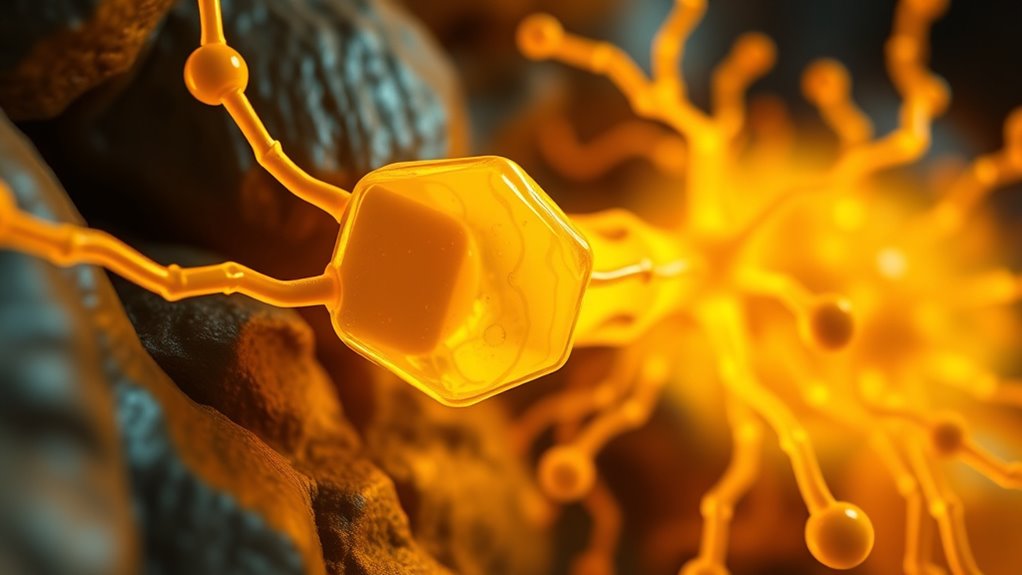Vitamin B5 doesn’t passively diffuse into mitochondria; instead, specialized transport proteins embedded in the mitochondrial membrane actively carry it inside. These carrier proteins recognize pantothenic acid, latch onto it, and use energy from electrochemical gradients to transport the molecule across the membrane. This process guarantees efficient delivery for coenzyme A synthesis, essential for energy production. If you want to uncover how these transporters work and why this matters, keep exploring this fascinating process.
Key Takeaways
- Specific transporter proteins embedded in mitochondrial membranes actively recognize and bind vitamin B5 molecules in the cytoplasm.
- These transporters undergo conformational changes to facilitate the energy-dependent movement of vitamin B5 into mitochondria.
- Transport relies on electrochemical gradients maintained by mitochondria, providing the energy needed for active transport.
- The discovery confirms vitamin B5 does not passively diffuse but requires specialized carrier proteins for mitochondrial entry.
- Proper function of these transporters is essential for coenzyme A synthesis and cellular energy metabolism.

Scientists have discovered that the vitamin B5 molecule, also known as pantothenic acid, actively enters mitochondria—the powerhouses of your cells—where it plays a essential role in energy production. This finding sheds light on a long-standing metabolic mystery about how essential nutrients reach the core sites of cellular activity. Previously, scientists understood that vitamin B5 was critical for synthesizing coenzyme A, a molecule fundamental to energy metabolism. Yet, the exact mechanism by which pantothenic acid gained entry into mitochondria remained elusive. Now, recent research reveals that specific transport proteins embedded in mitochondrial membranes facilitate this process, allowing vitamin B5 to efficiently reach its destination. These transport proteins are highly selective, ensuring that only the necessary molecules are transported at the right times. As you learn about these transporters, you’ll see that they act like gatekeepers, selectively recognizing pantothenic acid and shuttling it across the mitochondrial membranes. These specialized proteins are part of a larger family called carrier proteins, which are tasked with ferrying essential molecules into and out of mitochondria. The process begins in the cytoplasm, where pantothenic acid is abundant, especially in tissues with high energy demands like muscles and the brain. Once in the cytoplasm, the transport proteins latch onto the vitamin B5 molecule and undergo conformational changes, effectively pulling it into the mitochondrial matrix. This active transport requires energy, typically in the form of electrochemical gradients maintained by other mitochondrial functions, ensuring that the process is efficient and tightly regulated. Understanding how vitamin B5 enters mitochondria is more than just a scientific curiosity; it has practical implications. For instance, it highlights potential targets for addressing metabolic disorders linked to energy deficits. If the transport proteins are malfunctioning or deficient, the delivery of pantothenic acid could be compromised, impairing coenzyme A synthesis and, consequently, cellular energy production. Such disruptions could contribute to fatigue, neurodegeneration, or muscle weakness. Recognizing this pathway also opens doors to therapeutic interventions—either by enhancing transporter activity or designing supplements that can bypass transport limitations. Ultimately, this discovery resolves a significant piece of the puzzle in cellular metabolism. It confirms that vitamin B5 doesn’t passively diffuse into mitochondria but relies on specialized proteins to ensure its delivery. This precise mechanism underscores the complexity of nutrient transport and the importance of mitochondrial health for overall well-being. By understanding how vitamin B5’s molecule enters mitochondria, you gain insight into the intricate ballet of cellular processes that sustain life at the microscopic level.
Frequently Asked Questions
How Does Vitamin B5 Deficiency Affect Mitochondrial Function?
If you’re deficient in vitamin B5, your mitochondrial function suffers because you lack enough coenzyme A, which is essential for energy production. Without enough B5, your mitochondria struggle to carry out fatty acid oxidation and the Krebs cycle efficiently. This can lead to fatigue, muscle weakness, and metabolic issues. Ensuring adequate B5 intake helps maintain healthy mitochondrial activity and supports your overall energy metabolism.
Are There Other Molecules Involved in Vitamin B5 Transport?
Yes, other molecules assist in vitamin B5 transport. You’ll find that carrier proteins, like the mitochondrial chaperones, help shuttle B5 into the mitochondria. These proteins recognize and bind to vitamin B5, guaranteeing it reaches the mitochondrial matrix efficiently. Additionally, phospholipids in mitochondrial membranes facilitate the process by maintaining membrane fluidity, which supports the transport. Together, these molecules coordinate to ensure vitamin B5 effectively enters and functions within mitochondria.
What Are the Health Implications of Impaired Vitamin B5 Mitochondrial Entry?
If vitamin B5 can’t enter your mitochondria properly, you might experience fatigue, muscle weakness, or nerve issues because your body struggles to produce energy efficiently. This impairment can also affect fat metabolism, leading to skin problems or mood disturbances. You should prioritize a balanced diet rich in B5 sources like eggs, fish, and whole grains, and consult a healthcare professional if you notice symptoms, to prevent long-term health complications.
Can Vitamin B5 Supplementation Improve Mitochondrial Efficiency?
Imagine someone with fatigue and muscle weakness improving after vitamin B5 supplements. Yes, supplementing with B5 can boost mitochondrial efficiency by providing more of the coenzyme A needed for energy production. It helps optimize metabolic processes, especially in those with deficiencies. While benefits vary, increasing B5 intake generally supports better mitochondrial function, leading to enhanced energy levels and overall well-being.
How Does Mitochondrial Uptake of Vitamin B5 Vary Across Different Cell Types?
You’ll find that mitochondrial uptake of vitamin B5 varies among cell types due to differences in transporter expression. Some cells, like liver and muscle cells, have higher levels of specific transporters, allowing more efficient vitamin B5 entry. Others, such as neurons, may have different transporter profiles, affecting how well they import vitamin B5. These variations influence each cell’s ability to produce coenzyme A and maintain metabolic functions.
Conclusion
Now that you see how vitamin B5’s molecule navigates the mitochondrial gate, it’s like watching a tiny traveler weaving through a bustling city’s maze. This discovery clears the fog around its journey, revealing the elegant pathway that fuels your cells’ energy. With each step, you realize that understanding these microscopic routes isn’t just science, but a glimpse into the intricate dance sustaining your very life—reminding you that even the smallest molecules have a story worth telling.










